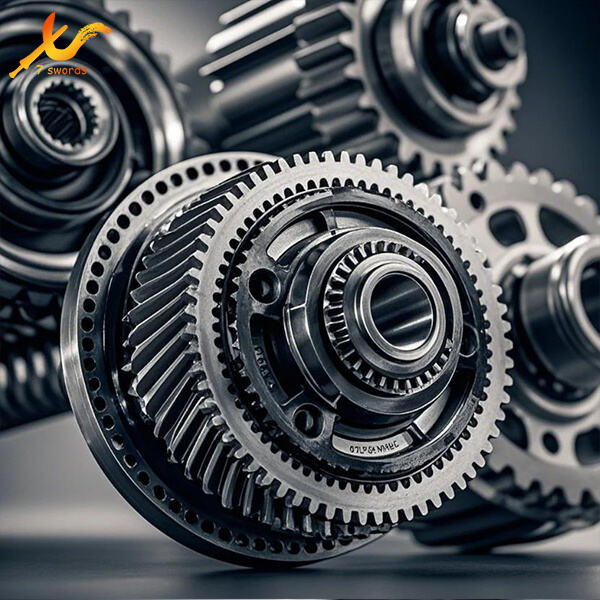المبنى 49، حديقة فومين الصناعية، قرية بينغهو، منطقة لونغغانغ
مغلق يوم الأحد
هناك مجموعة متنوعة من أنواع العجلات التي يمكنك العثور عليها داخل السيارات. لكل نوع وظيفة محددة يقوم بها. أمثلة على أنواع العجلات الشائعة: عجلات ذات أسنان مستقيمة، عجلات حلزونية، عجلات مخروطية. هذه العجلات المستوية تكون عادة فعالة جدًا عندما تكون السيارة متوقفة ولكنها تحتاج إلى كميات كبيرة من القوة. تُستخدم بشكل شائع في التطبيقات التي تتطلب الصلابة. لكن عندما تكون السيارة تتحرك بسرعة، يتم تصميم العجلات الحلزونية للعمل بهدوء وسلاسة. أسنانها مائلة لتساعد في تقليل الضوضاء. عندما يكون من الضروري تغيير اتجاه القوة، مثل عند الدوران في الزوايا، تُستخدم العجلات المخروطية. كل من هذه العجلات لديه دور حيوي لضمان عمل السيارة بشكل جيد.
تُصنع العَبَّارات في السيارات من المعادن ذات القوة العالية مثل الصلب أو الألمنيوم. ما يجب أن تفعله العَبَّارة سيحدد المعدن الذي تختاره. تحتاج هذه الأسنان إلى أن تكون خفيفة الوزن ولكنها قوية، لذلك يتم صنع بعض العَبَّارات من الألمنيوم. هذا يمكّن السيارة من السير بسرعة أكبر باستخدام أقل طاقة ممكنة. ومع ذلك، فإن العَبَّارات التي يجب أن تحمل حملًا ثقيلًا أو تعمل عند درجات حرارة عالية تُصنع عادةً من الصلب بسبب قوته وصلابته.
كيفية تصميم التروس ولكن يهم أيضًا الشكل. يجب أن تكون أسنان التروس على الشكل أو الحجم المناسب، وإلا لن تعمل بكفاءة. يمكنك جعل الأسنان أصغر لكن قد تكسرها. وإذا كانت كبيرة جدًا، فقد لا تتداخل مع التروس الأخرى. الزاوية بين الأسنان مهمة أيضًا لأنها تعطي تقديرًا لقوتها، متانتها، أدائها وصوتها عند تشغيل السيارة.
الأشخاص حول التروس لا يجعلونها تُصنع بشكل أسرع، ولكن مزيج التروس المستخدمة يُقاس من خلال نسب التروس. قالوا كم عدد الأسنان الموجودة في الترس الواحد ثم الآخر حتى يتداخلان معًا. هذه النسبة التربيعية تشير إلى عدد الدورات التي سيقوم بها الترس الأول ليتمكّن الترس الآخر من إكمال دورة واحدة. الملايين من المجموعات التقنية في مجال السيارات، والتي تُسمى نسب التروس، هي بالتالي حيوية حيث تحدد مدى سرعة دوران العجلات بالنسبة لدوران المحرك.

يمكن أن تؤدي نسب المعدات المختلفة إلى تغيير أسرع سرعة يمكن للسيارة أن تسير بها وكيفية تسارعها. وهذا يعني أنه عندما تكون نسبة التروس أعلى، فإنها ستمنح السيارة قوة أكبر لكنها لن تكون سريعة بنفس القدر. في الظروف العادية للقيادة، يعمل ذلك كمساعدة لصعود المرتفعات. وعلى النقيض، مع نسبة سكة منخفضة، تتحرك السيارة بشكل أسرع لكنها تفتقر إلى القوة. هذا مفيد عند السفر على الطرق المستوية. السائقون المألوفون مع نسب التروس سيفهمون أنه في بعض الأحيان يحتاجون للتضحية بالسرعة من أجل العزم وبالعكس حسب الوضع الحالي.

يتكون العلبة من تسلسل للعتلات تتبع بعضها البعض بالترتيب. ما يوفره هذا الترتيب للسائق هو مجموعة من نسب العتلة. يمكن للسائقين تغيير العتلة يدويًا أو ترك السيارة تقوم بذلك تلقائيًا، حسب نوع العلبة. كما يتضمن أيضًا عمود القيادة الذي ينقل القوة، والتفاضلي (يسمح لكل عجلة بالدوران بسرعات مختلفة) والعجل (يربط العجلات بالسيارة) وغيرها. يعملون معًا لضمان أن تعمل السيارة بسلاسة وكفاءة.

اختيار العتلة المناسبة: له أهمية كبيرة لأن ذلك يمكن أن يؤثر على أداء السيارة وكذلك استهلاك الطاقة. استخدام نسبة العتلة الصحيحة يتيح للسائقين التأكد من أن المحرك يعمل في نطاق السرعة الأمثل للظروف. على سبيل المثال، إذا احتاجت السيارة إلى الصعود على تل شديد الانحدار، فإن نسبة العتلة المنخفضة تمكن السيارة من الحفاظ على السرعة دون إجهاد المحرك بشكل مفرط. وهذا يمنع المحرك من العمل الزائد وتجنب ارتفاع درجة حرارته.
جميع الحقوق محفوظة © شركة شنتشن بيرفكت برسيزيون برودكتس المحدودة — سياسة الخصوصية—المدونة